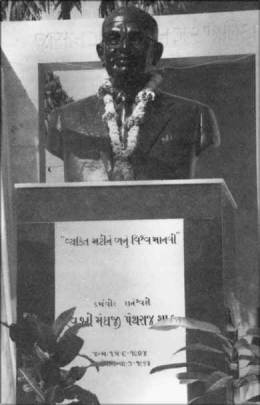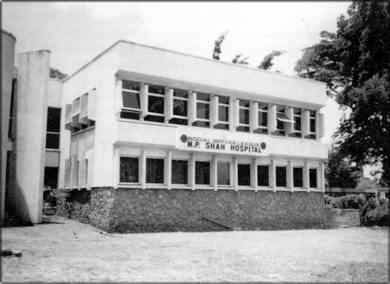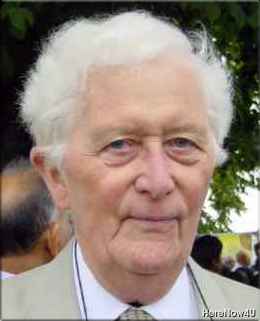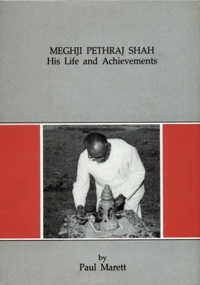
By 1953, Meghjibhai had succeeded in life beyond the dreams of the fifteen-year old boy who had stepped ashore in Africa in 1919, or indeed of the youth who had set up his first business in 1922. It took considerable courage to step down from his business career. But he was determined to do so. He had achieved a lot in this career, raising his family from poverty to wealth. He was not going to be a slave to his wealth. The total capital of his companies now amounted to some 2.5 million pounds. Three thousand Africans, a hundred and twenty-five Indians and many Europeans were employed in his various enterprises. It needed heroic strength of character to leave the position of power, which such a business empire afforded. Wealth and success had not corrupted Meghjibhai. In simplicity of dress and humility of behaviour he had not changed since his days as an ordinary teacher in the village school in Dabasang. Thus he won the loyalty and respect of his managers and workers of all races. Whilst Africans and Indians were generally happy and proud to work under white company owners, there were very few Indian industrialists like Meghjibhai in whose concerns Europeans were proud to serve. His reputation was such, as an industrialist and a financier that many Europeans sought to work for him.

Meghjibhai's bust at the Medical College in Jamnager
Now Meghjibhai was determined to step down and at the end of 1953 he retired from the management of his many enterprises. He handed over the management of his business in Africa to an Englishman, Mr. Grey, who had been regional manager in East Africa for Standard Bank. The Bombay office was entrusted to C. U. Shah, who also took over the management of Meghjibhai's charitable trust in India. Meghjibhai was a shrewd judge of character. Once he had tested a man he would affectionately make him his own.
It took a considerable amount of courage to retire at what was, after all, an early age, for Meghjibhai was still under fifty. In fact, he had the idea of early retirement in his mind for a considerable time, seeing retirement not as a move to a life of idleness but as a call to the service of humanity in a different way. A small incident a few years before had sown the seed of his desire to make a radical change in the direction of his life.
It happened in 1948. Meghjibhai was going to Bombay on business. During the flight the plane met sudden and unexpected turbulence to the great alarm of the passengers. The plane flew on safely but Meghjibhai was shaken by the experience. He was unwell at the time and may have blacked out momentarily. It was not so much the fear of a crash and death but the sudden realisation, which penetrated to his very soul, that if his life were to end now he would leave a great fortune in monetary terms but he would also die owing a spiritual debt. He began to prepare a balance sheet of his life. His life until now had passed in the acquisition of wealth. It had not been totally without merit: he had brought employment and prosperity to many. But he had not been able to do much towards the positive utilisation of his wealth for worthy ends. When a person dies he cannot take earthly wealth with him. What he does take is his karma, the results of his good and bad deeds. Someone who postpones good deeds of charity to old age and engages himself solely in the acquisition of wealth cannot be said to have lived a successful life. Life is transient and if it ends in a sudden plane crash, wealth is worth nothing. Mr. C. U. Shah remembers meeting Meghjibhai at the airport after this flight and saw from his face that he was confused and upset. He told Chimanbhai what had happened on the aircraft and added 'Let us do something before it is too late'. Thus a few minutes' turbulence in an aircraft flight ended the struggle, which had, in fact, been going on in Meghjibhai's mind for many years. Meghjibhai took this incident as a divine warning and determined to set a course for the betterment of his soul. The most intimate witness of Meghjibhai's mental struggle was his kind and calm wife, Maniben. Often he had said to her that the mere hoarding of wealth makes it worthless. It gets destroyed.
There is no merit in hoarding wealth: it is sinful to accumulate money beyond one' s reasonable needs. After returning from that most significant plane journey, Meghjibhai informed Maniben of his intention to retire before too long and made up his mind that this would be at the end of 1953. When he told his wife she agreed completely with his plans. Meghjibhai had already, in fact, started charitable activities and had funded various projects for social welfare and the promotion of education. But he did not feel that this was enough. Simply handing over money is easy enough for a rich man: it is far more important, and meritorious, to take a real and active interest in charitable work. The inception of Meghjibhai's large-scale organised philanthropy, in East Africa and in India, can thus be dated to 1948, although, as mentioned earlier, he had been heavily involved in raising money in 1943 for the Bengal Famine Relief Fund, and earlier still, in 1936, as Treasurer of the Saurashtra Famine Committee.
Meghjibhai's donations in East Africa were generous indeed: there was hardly a publicly funded school or hospital in Kenya to which he had not given a contribution, often of a large amount. He helped African students to go abroad for higher education, providing over the years from 1949 to 1959 thirty-five scholarships for African young people to study in India, at a total cost of 400,000 shillings. As his wealth increased, so did his charitable donations. He set up the Meghjibhai Foundation in Nairobi in 1948 with a sum of one million shillings, and amongst the organisations committed to social service, which received generous support, were the Indian Association, the Gujarati Hindu Union and the Nairobi Social Service League. This last-named association, originally known as Samaj Seva Mandal, was formed in 1933 by a small group of people who were particularly concerned with the plight of individuals unemployed because of the recession. Its work has since expanded considerably, its membership is now over 1,500, and its main concern is the M. P. Shah Hospital in Nairobi. The project for this hospital in Nairobi was originally mooted in the nineteen-thirties when the only general hospital in Nairobi was the so-called Native Hospital in ramshackle premises. The Social Service League was already running a dispensary and planned a modest hospital on the same site.

However, the war caused the project to be deferred, though some funds had been collected. When the fund was reopened after the war the donation list was headed by 'the truly marvellous sum of 125,000 sh. given by the great philanthropist and business magnate Seth Meghji Pethraj Shah' to quote a typescript history of the Social Service League held in the M. P. Shah Hospital records. ('Seth' is an honorific accorded to prominent members of the merchant community.) The project was not yet out of the woods, costs were rising, and eventually, rather than build from scratch, the Social Service League negotiated to take over the Parklands Nursing Home. This was a private venture of a group of medical practitioners and businessmen. Meghjibhai had, in fact, provided financial backing for the nursing home when it was set up, through his finance company. In 1959, after Meghjibhai made one of his characteristically rapid decisions to provide half a million shillings, the Social Service League was able to buy Parklands. In fact his generosity went further than that, for he was to agree (shortly before his untimely death) that he would match other contributions, pound for pound, and the League promised to name the hospital after him. Meghjibhai, in fact, promised one and a quarter million shilling in all. After Meghjibhai died, Maniben stood by his word: she met the Chairman of the Social Service League, Dr. R.I. Patel, and the gift was duly paid over. Later the Hospital was to incorporate the former Lady Grigg Maternity Hospital, to which Meghjibhai had previously been a generous donor. Today the M. P. Shah Hospital has over 100 beds and the most modern equipment, with fine modern buildings standing in five and a half acres of land. An Almoner Fund from Meghjibhai's donation is set aside to subsidise patients who cannot afford the full costs of treatment.
 Dr. Paul Marett
Dr. Paul Marett

